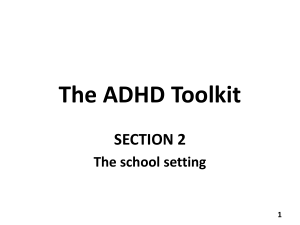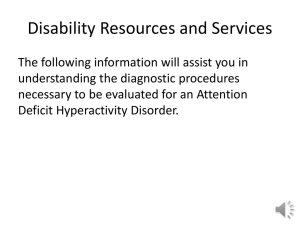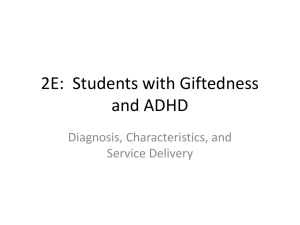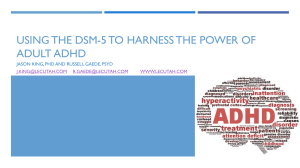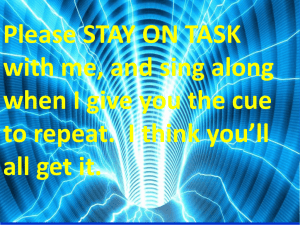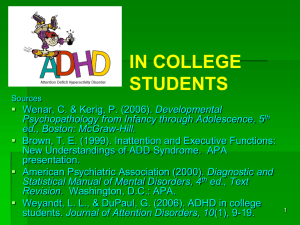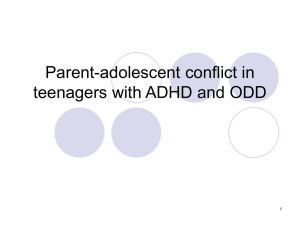Events - Springer School and Center
advertisement
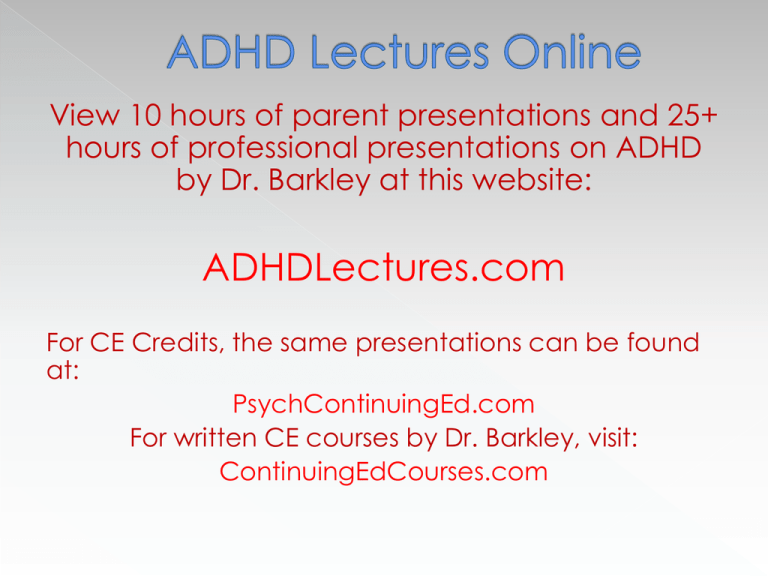
View 10 hours of parent presentations and 25+ hours of professional presentations on ADHD by Dr. Barkley at this website: ADHDLectures.com For CE Credits, the same presentations can be found at: PsychContinuingEd.com For written CE courses by Dr. Barkley, visit: ContinuingEdCourses.com A disorder of developmentally inappropriate degrees of: › Inattention › Hyperactive and impulsive behavior Arises in childhood Persistent over time Results in impairment in major life activities Evaluation Education Medication Modification (of Behavior) Accommodation › Restructuring the home › Changes in school › Assistance in the community Parent Education About ADHD Psychopharmacology › Stimulants (e.g., Ritalin, Adderall, etc.) › Noradrenergic Medications (e.g., Strattera) › Tricyclic Anti-depressants (e.g., desipramine) › Anti-hypertensives (e.g., Catapres, Tenex) Parent Training in Child Management › Children (<11 yrs., 65-75% respond) › Adolescents (25-30% show reliable change) Teacher Education About ADHD Teacher Training in Classroom Behavior Management Special Education Services (IDEA, 504) Residential Treatment (5-8%) Parent/Family Services (25+%) Parent/Client Support Groups (CHADD, ADDA, Independents) Biofeedback (Neurofeedback, or EEG Training) Working Memory Training Mindfulness Meditation Training Omega 3/6 Food Supplements (fish oils) Elimination Diets – removal of sugar, additives, etc. (Weak evidence) Megavitamins, Anti-oxidants, Minerals (No compelling proof or disproved) Sensory Integration Training (disproved) Chiropractic Skull Manipulation (no proof) Play Therapy, Psycho-therapy (disproved) Self-Control (Cognitive) Therapies (in clinic) Social Skills Therapies (in clinic) › Better for Inattentive (SCT) Type and Anxious Cases The Scientific Parent › Read widely › Experiment with management methods › Be a skeptic The Executive Parent › Take charge; become an advocate The Principle-Centered Parent › Be proactive; Begin with the end in mind; Put first things first; Seek to understand, then to be understood; Think win/win; Synergize; Find sources of renewal Get into treatment as soon as possible (meds., counseling, organizing advice, treatment for coexisting disorders, etc. ) Let the non-ADHD parent handle homework and school-related issues, if necessary Alternate nights with partner as to who supervises for the ADHD child Let the non-ADHD parent handle time sensitive household responsibilities while the ADHD parent gets the non-time sensitive ones Put yourself in time-out when emotions escalate toward family members Always review major child discipline decisions with the non-ADHD parent The non-ADHD parent drives to children to their activities if the ADHD parent is not on medication That you stop and think -BEFORE you act ! Use your hindsight (looking backward) To get your foresight (see what’s next) To anticipate and prepare for the future So you can be more effective and attend to your long-term welfare and happiness This is “executive functioning” (EF) There are 6 “cognitive” or “mental” components or parts to EF Your children are a unique combination of your extended families’ genetic traits These interact with your family environment to make your child even more unique And all that interacts with unique events that occur to your child as they develop to form a highly unique individual You don’t get to completely design who your children are or are going to be; they come with hundreds of traits, abilities, talents, and deficits that are largely not of your doing Your role as a parent is closer to that of a shepherd to a lamb than one of an engineer or sculptor to raw materials or a block of clay So, provide for high quality, safe, nurturing, supportive and stimulating environments where you can (including the community in which you choose to live) Create opportunities for success when you can – open the doors for chances to improve or excel Encourage (reward) pro-social behavior when possible Discourage anti-social and ineffective behavior when and where ever possible Break up deviant peer relationships whenever detected Make environmental accommodations for your child’s deficits where you are able to do so And then enjoy the show. The rest is largely out of your control Children with ADHD have problems with using their internal sense of time to guide their behavior; time escapes them They are also less able to wait for consequences or events and to defer gratification – they get impatient So pay attention to the E-R-O arrangements in life › Events that need to be addressed › Responses to prepare for them › Outcomes or consequences from them Get them as close together as you can Break lengthier tasks down into smaller ones and do these smaller ones more often If they have to wait for something, divert their attention away from the time interval and toward something else more interesting in the situation (watched pots never boil) If they have to work for a period of time longer than a few minutes, make the time interval physical (externalize it) › Use timers, clocks, counters, or other devices that show how much time there is to do something and how fast it is passing. ADHD creates problems for a child’s working memory – the ability to hold in mind what one is supposed to be doing So don’t rely so much on their working memory Make important rules or other reminders and information physical in situations where it is important for them to remember something Use sticky notes, cards, cues, and other ways of physically representing information in that setting to help guide their behavior Have them rehearse “when-then” plans in a situation to help prime them recall what they are to do the next time they are in that situation ADHD creates a deficit in our capacity for self-motivation (internally created will-power) Children with ADHD cannot persist at tasks that involve long delays to the consequences for getting them done This is why they can play videogames for hours or do things they really enjoy and cannot do homework and chores for more than a few minutes. You need to think “win/win” when it comes to work to be done When tasks must be done for which there are no immediate consequences, then add some artificial ones to that situation Add tokens, points, money, privileges, or other rewards that can be earned frequently throughout the task; change them up periodically › Points can be cashed in later for bigger, salient rewards Also, have them visualize the goal and its rewards Even make or find a picture of it if possible and place it in front of them while they work Then have them talk about the goal and the final rewards periodically while they are working on the task Give feedback more often and more quickly ADHD children are punished more often than other children, but it doesn’t work To deal with a problem behavior, always start with a reward program Think about the misbehavior and what your child should have done instead Now with that positive alternative behavior in mind, think about how to encourage it Then arrange for positive feedback and rewards to occur whenever you see that behavior; prompt the behavior if necessary Do this for several days before you focus on punishing the alternative misbehavior Only when a situation rewards good behavior is punishment likely to succeed for misbehavior Even then, punishment must be swift (not severe) to be effective – act within 10 seconds of misbehavior ADHD causes problems with the ability to do mental tasks; they can’t hold the information in mind and manipulate it as well as others So break tasks and problems into pieces Think about how you could make those pieces physical Let them manually work on and manipulate the pieces of the task or problem – help them to use their hands in solving the problem Act, don’t yack! Parents talk too much When you must instruct, praise, or reprimand your child, go to them Put your arm around their shoulder or your hand on their arm or hand › This makes communication more intimate Look them in the eyes › think Clint Eastwood Briefly say what you have to say › Keep it short, business like, and to the point If appropriate, have them repeat back what you have just said Don’t be just a reactive parent (or teacher) Review your child’s life for typical problem situations › Stores, restaurants, church, while visiting others’ homes, play-groups, homework, while you are on the phone, chores Now think about what you could do just before you enter those situations to head off any potential behavior problem Now develop your transition plan to use the next time you are about to enter that situation Stop! Wait before you enter that setting Review with your child a few rules that they are to follow in that situation › Have them repeat them back to you › Write them on a card to give to your child if necessary Explain the rewards your child will earn in that situation for following the rules › Have them repeat them back to you Explain the punishment they will receive if rules are broken › Have them repeat them back to you Give them something to do in that setting Enter the situation and follow your plan Give frequent feedback and evaluate how well things went when you are done ADHD makes children less able to work independently, especially for long periods of time Break such tasks into shorter work periods Review the goals or work to be done at the beginning of each short period Check back with your child at the end of each period to review how much is done Give them positive feedback for attaining these short-term goals If they were not successful, break the task down into even shorter periods of work and review that work with them more often Remember the 10 & 3 rule › 10 minutes of work, 3 minutes break A lot of work we assigned to children is not very important in the long run Yet by giving them lots of trivial things to do we create more problems with them Know which battles are worth fighting and which should not be fought Focus instead on the most important chores, tasks, and directives Eliminate giving those that are of less importance for awhile ADHD delays a child’s capacity for selfcontrol and independence from others Remember the 30 percent rule › Reduce your child’s age by 30% to find their executive age – age of self-regulation Now reduce your expectations, and the responsibilities, or chores you give them to this age level You have just reduced the potential for conflict with your child by matching your expectations to their actual abilities Always remember that ADHD is a neurological and genetic disability, not a choice You are going to make mistakes in managing your child with ADHD › That is OK as long as you try to get it right the next time › Forgive yourself for these occasional screw-ups; we all make them, even experts Others are going to misjudge your child; forgive them their ignorance of ADHD Your child will make more mistakes than others › That is OK as long as they try to get it right the next time › Forgive them for these mistakes as well › Practice a daily exorcism of child problems › Find ways to restore a positive view of your child Understanding and managing a child with ADHD boils down to following 12 basic principles of parenting or teaching Follow them and you will do as well as you can as a parent or teacher to raise a happier, more effective, and well adjusted child And you will have a more supportive and peaceful family or classroom You will also have built the foundation for a strong relationship or bond with the child with ADHD



